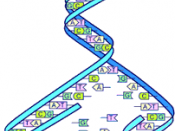Science is a creature that continues to evolve at an ever-increasing rate. The transformation from tree shrew, to ape, to human far exceeds the time for the transformation time from an analytical machine, to a calculator, to a computer. However, science, in the past, has always remained distant. Science has allowed advances in production, transportation, and even entertainment; but never in history will science have an affect on our lives, as genetic engineering will undoubtedly do. For the last decade, science has made vast improvements in genetics, monitored by the Human Genome Project. The goal of this organization is to identify and understand the entire genetic constitution. "They have the daunting task of identifying and mapping all of the eighty thousand genes, in human DNA, they are making new discoveries weekly" (Reuterlinkextra). With these discoveries comes many implications, In reviewing the literature genetic engineering needs to be banned because of the social, religious, ethical, and legal implications.
The first step to understanding genetic engineering is to know the start of its creation. Genetics achieved its first foothold on the secrets of nature's evolutionary process, when an Austrian Monk named Gregor Mendel developed the basics of how genetics work. Using this, scientist studied the characteristics of organisms for the next one hundred years following Mendel's discoveries. These early studies concluded that each organism has two sets of character determinants, genes (Stableford 16). For instance, in regards to eye color, a child could receive one set of genes from his or her father that were encoded one blue, the other brown. The same child could also receive from its mother two brown genes. The conclusion is that the child would have a three out of four chance of having brown eyes and a one out if four chance of having blue eyes...


